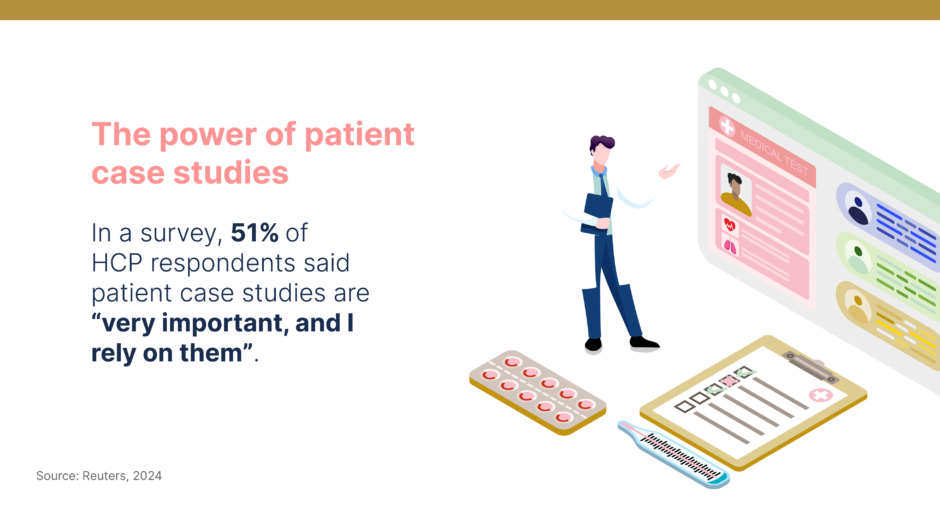As HCPs seek richer learning experiences, interactive patient case studies could be the next big thing. Are they a way for marketing and medical teams to connect clinical evidence to the real-world and stand out?
Words by Jade Williams
As a pharmaceutical professional, you’re constantly told that clinicians want more than polished trial data from the industry. Instead, they’re looking for education that feels real, balanced and trustworthy. Traditional patient case studies have long delivered on that need, but as learning habits evolve, it may be time to reimagine how these stories are told and give classic offerings a little more punch.
From static to dynamic
Traditional case studies, which typically consist of just text and a few images, often leave readers on the sidelines of the clinical story. They inform, but don’t immerse, and increasingly content needs to do more.
Interactive case studies have the power to turn standard experiences on their head. By allowing users to explore cases visually and engage directly with diagnostic decision points, these tools transform passive reading into active learning. They replicate the iterative process of real-world medicine – assess, decide, reflect, correct – giving HCPs the freedom to test their understanding in a safe environment.
As an expert on interactive content, Tim Uden, Creative Director, EMJ, says adding interactive elements can help clinicians better engage and retain information. “When people interact with the elements on page, interactive content creates faster and proven memory retention,” he explains. “Through publishing interactive content, we are also able to ask the reader questions, and understand where their gaps in knowledge are by measuring hotspots.”
The results speak for themselves. EMJ’s data shows that interactive studies receive, on average, three times more views than static versions and deliver 23% more time on page. That’s a tangible sign of how interactivity fuels curiosity and deeper engagement. A client and advocate of interactive sums it up nicely: “Interactive content is extremely important… The future generation, my kids, they grow up with it – so we’re basically paving the future here.”

Why authenticity matters
This new wave of patient case studies could not have come at a better time. A 2024 Reuters survey found that 51% of clinicians said that they find patient case studies ‘very important’ and that they rely on them. While this is largely positive, it shows that uptake isn’t absolute. As it becomes more difficult to engage HCPs, they are becoming increasingly selective about where they focus their attention, so all content must shift up a gear.
“I’m a clinician, so I see ‘case studies’ every day,” says Dr Harry Gibbs, Programme Director, Outpatients Programme, and Deputy Director, General Medicine, The Alfred Hospital, Melbourne. Dr Gibbs admits he’s most drawn to hard data, but he recognises the power of case-based learning when done well. In particular, he like a case study that “speaks to the burden of disease experienced by an individual and the benefit of a treatment”.
That, ultimately, is the key. The value of a patient case study lies not in showcasing a product, but in revealing the human impact – the weight of disease and the relief of improvement. When done right, these stories allow the data to breathe. They humanise clinical innovation, connecting statistics to real patient lives. They show, not tell.

Lessons for pharma
For pharma companies, this new way of delivering education represents both an opportunity and a responsibility. It’s no longer enough to tell a story; the challenge now is to transform real patient experiences into immersive educational moments that feel new, innovative and ultimately improve care. As Dr Gibbs emphasies, authenticity must remain the foundation. Interactive case studies “need to teach HCPs something that they didn’t know. Not just marketing. Not with a biased and obvious point that leaves out the nuance of real practice”.
That nuance, the messy, human reality of patient care, is precisely what makes these stories resonate. When clinicians see their own dilemmas reflected, their engagement deepens. When they see genuine problem-solving and balanced outcomes, their trust grows. As Dr Gibbs warns, “I hate obvious marketing – get rid of that.” HCPs, like any audience, don’t want to be convinced. They want to be informed, respected and occasionally surprised.

The future: immersive learning
As technology continues to evolve, so too will the possibilities for interactive learning. Uden is already imagining the next frontier: “In the future, I’d love to see an interactive patient case study delivered via a VR headset. This would allow HCPs to observe a case or procedure first-hand and understand how it works.” This kind of immersive education could soon bring case learning to life in entirely new ways. In time, clinicians may not only be able to interact with medical education, but actually step into it, experiencing the consequences of each decision as if they were there.
Where empathy meets innovation
It’s undeniable that interactive patient case studies offer a format that doesn’t just present information, but brings it to life – closing the gap between data and decision, and evidence and experience. For pharma, the takeaway is simple but vital: be real, be human and teach – don’t sell. Those who embrace this approach won’t just attract attention; they will build credibility in the eyes of the professionals who matter most.









